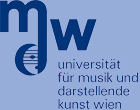List of Vienna Talk 2010 presenters

Amir, Noam
(P,O)Andermann, Martin
(P)Arzt, Andreas
(O)Bastos, Patricia Lopes
(P)Beauchamp, James Warren
(O,O)Bendl, Ingrid
(P)Bertsch, Matthias
(P)Bisesi, Erica Elisabetta
(O)Buen, Anders
(O)Campbell, Murray
(O)Cano, Estefania
(P)Carral, Sandra
(P)Carter, Stewart Arlen
(O)Chatziioannou, Vasileios
(P)Chick, John
(O)Curtit, Marthe
(O)Dalmont, Jean-Pierre
(O)Davidenkova, Ekaterina
(O)Demoucron, Matthias
(O)Doutaut, Vincent
(P)Dörfler, Monika
(O)Flossmann, Sebastian
(O)Fouilhe, Eric
(O)Fricke, Jobst P.
(O)Fritz, Claudia
(O)Presentation type: Oral / Invited
Violin sound quality: nasality and clarity
This study aims at investigating what “nasality” and “clarity” means for violinists, and what their acoustical correlates are. Based on his measurement of the acoustical properties of a large range of violins, Dünnwald (1991) associated a large amplitude in the band 650-1300 Hz with “nasality” and a low amplitude in the band 4200-6400 Hz with “clarity”, but without any perceptual testing. Therefore, Fritz et al. (2009) conducted listening tests with English speaking violinists to analyse the relationship of these verbal descriptors to specific acoustical features of computer-generated (“virtual”) violin sounds.
The listening test was redone with French speaking violinists. To go beyond the simple labelling, the participants were asked to give explicit descriptions of what “clair” and “nasal” means for them and the reasons of their choices.
The results are very similar to those obtained in English and conflict with Dünnwald’s suggestions. Like for “clear”, the results for “clair” yielded a high degree of consistency between subjects and the term was associated with an increase of energy in the frequency range 1.6 kHz to 3.2 kHz. For “nasal”, subjects could be divided into two groups, each showing high consistency. An increase in the band 1.6 kHz to 3.2 kHz increased “nasalité” for the first group while decreasing it for the second one. Linguistics analyses were then conducted on the descriptions given by the participants and were put in correspondence with the results from the listening test. While acoustical parameters cannot discriminate the two meanings of “clair” (“rich in high frequencies” and “precise”/“definite”), the two groups for “nasal” were semantically identified as corresponding to two meanings of nasality (the “vocal nasality” referring to the quality of a twangy voice for one group, and the “phonetical nasality” and/or the fact that the sounds appear low-pass filtered for the other group).

Gingras, Bruno
(O)Goebl, Werner
(P)Granzotto, Nicola
(P)Grosshauser, Tobias
(O)Guettler, Knut
(O)Hansen, Uwe J
(O)Kartofelev, Dmitri
(P)Kausel, Wilfried
(P)Kemp, Jonathan
(O,O)Klaus, Sabine Katharina
(O)Kostek, Bozena
(O)Lambrechts-Douillez, Jeannine
(O)Lohri, Angela
(P)Marchand, Sylvain
(O)Mayer, Alexander
(P)Moore, Thomas
(O,O)Morrison, Andrew
(O)Myers, Arnold
(O)Nederveen, Cornelis J
(O)Niedermayer, Bernhard
(O)Norman, Lisa
(O)Oehler, Michael
(O)Otcenasek, Zdenek
)Pyle, Robert W.
(O,O)Reuter, Christoph
(O)Richardson, Bernard
(P,O)Rose, Maria
(O)Rossing, Thomas D.
(O,O)Sanchez, Monica
(P)Schoonderwaldt, Erwin
(O)Sharp, David
(O)Siddiq, Sadjad
(P)Skala, Jan
(P)Smith, Richard
(O)Sundberg, Johan
)Taylor, Crissman
(O)Tronchin, Lamberto
(O)Tsai, Pei Ju
(P)Vereecke, Hannes William
(P)Vergez, Christophe
(O)Widmer, Gerhard
(O)Worland, Randy
(O)Ziegenhals, Gunter
(O)van der Linden, Janet
(O)





